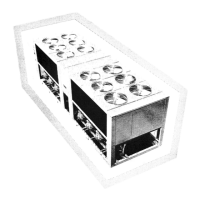rise higher), follow recommendations below:
a. Multiple smaller chillers may be applied in series, each
providing a portion of the design temperature rise.
b. Cooler fluid may be recirculated to raise flow rate.
However, mixed temperature entering cooler must be
maintained a minimum of at least 5° F (2.8° C) above the
LCWT.
c. Special cooler baffling is required to allow minimum flow
rate to be reduced.
OTE: Recirculation flow is shown below.
Maximum cooler flow — The maximum cooler flow (> 5
gpm/ton or < 5° F rise [> 0.09 L/s .kW or < 2.7° C rise])
results in practical maximum pressure drop through cooler.
1. Return fluid may bypass the cooler to keep pressure drop
through cooler within acceptable limits. This permits a
higher .T with lower fluid flow through cooler and mixing
after the cooler.
2. Special cooler baffling to permit a cooler flow rate
increase of 10% is available by special order.
OTE: Bypass flow is shown below.
Variable cooler flow rates — Variable rates may be applied
to standard chiller. Unit will, however, attempt to maintain a
constant leaving chilled fluid temperature. In such cases,
minimum flow must be in excess of minimum flow given in
Minimum Cooler Fluid Flow Rates and Minimum Loop
Volume table, and flow rate must change in steps of less than
10% per minute. Apply 6 gal.
exceed 3 gal. per nominal ton (3.25 L per kW) of cooling for
temperature stability and accuracy in normal air-conditioning
applications. (For example, a 30GBN200 would require 635
gal. [2403 L].) In process cooling applications, or for operation
at ambient temperature below 32 F (0° C) with low loading
conditions, there should be from 6 to 10 gal. per ton (6.5 to
10.8 L per kW). To achieve this volume, it is often necessary to
install a tank in the loop. Tank should be baffled to ensure there
is no stratification and that water (or brine) entering tank is
adequately mixed with liquid in the tank.
NOTE: Tank installation is shown below.
Cooler fouling factor — The fouling factor used to calculate
tabulated ratings was .00010 ft
2 • hr • °F/Btu (.000018 m2 •
°C/W). As fouling factor is increased, unit capacity decreases
and compressor power increases. Standard ratings should be
corrected using following multipliers:
FOULING FACTOR
English
(ft
2 .hr.°F/Btu)
SI
(m2 .°C/W)
CAPACITY
MULTIPLIER
COMPRESSOR
POWER
MULTIPLIER
.00025 .000044 0.991 0.995
.00050 .000088 0.977 0.987
.00075 .000132 0.955 0.979
.00175 .000308 0.910 0.952
Cooler protection — Protection against low ambient freeze-up
is required for unit operation in areas that experience
temperatures below 32 F (0° C). Protection should be in the
form of inhibited ethylene glycol or other suitable brine.
Even though unit cooler is equipped with insulation and an
electric heater that helps prevent freeze-up, it does not protect
fluid piping external to unit or if there is a power failure. Use
only antifreeze solutions approved for heat exchanger duty.
Use of automotive-type antifreezes is not recommended
because of the fouling that can occur once their relatively short-
lived inhibitor breaks down.
Draining cooler and outdoor piping is recommended if
system is not to be used during freezing weather conditions.
See Low Ambient Temperature Operation section page 46.

